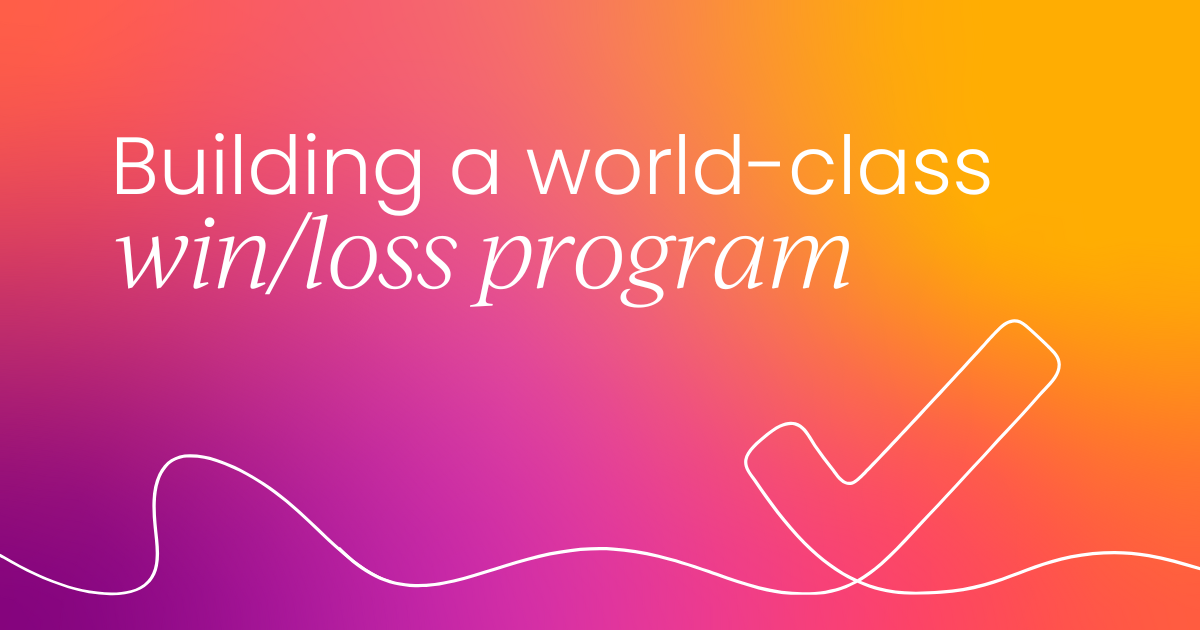Are you tired of losing deals and not really knowing why?
The goal of a win-loss program is simple: to improve your win rate.
But getting there means looking well beyond how your sales team is selling. You need to understand how your product or service is positioned, how it's priced, and, most importantly, how it's perceived by your buyers. Ultimately, your prospects make clear decisions based on the value they see (or don't see) in your offering.
In this article, you'll discover why direct buyer feedback is the real source of truth for win-loss analysis and how to structure your interviews for maximum impact.
You'll learn simple ways to probe deeper using techniques like the ‘Five Whys’ and ‘Laddering’ to move beyond surface-level answers and uncover the true decision drivers that will lead to actionable insights for your entire organization.
Why the buyer is the real source of truth
We often say the CRM is the source of truth in our business, but when it comes to win-loss, the real source of truth is the customer. CRMs often hold brief, biased notes entered by our teams, filtered through their own lens.
Let’s be honest: most sales reps aren't rushing to document the real reason a deal was lost, especially if it reflects poorly on their performance. That's why talking directly to your buyers is so critical.
Their words, their sentiments, and their decision-making logic are the keys to unlocking meaningful change. And the best part? They'll tell you if you ask the right questions and know how to listen.

The measurable impact of win-loss analysis
Win-loss analysis is a critical component for driving business and revenue growth through data-driven insights into your buyer’s decisions.Companies that consistently review wins and losses see double-digit improvements in win rates, and McKinsey estimates that a 10–20% win-rate lift can translate to 4–12% topline growth.
Surprisingly, more than 60% of the time, sales representatives have been wrong about why they win or why they lose, as reported by Clozd. By implementing proper win-loss analysis, organizations can achieve better sales effectiveness, stronger product-market fit, more targeted marketing, and strategic executive alignment.

What's in it for your teams?
Structured win-loss analysis provides measurable benefits across the board because it’s an organization-wide effort that drives growth.
For our sales teams, we can boost sales effectiveness, increase win rates, and ramp new hires faster by understanding the true drivers behind prospect and customer decisions.
For marketing and product marketing, we can create messaging and content that genuinely resonates with prospects while improving lead quality through better targeting.
For our product teams, we can refine the product roadmap and achieve ideal product-market fit based on actual customer feedback rather than our own assumptions.
And for our executive leaders in the business, we can foster strategic alignment on why we really win or lose deals, enabling better resource allocation and strategic planning.
The three core goals of our win-loss program
Our win-loss program is designed to drive measurable impact, and you might see some strong parallels to your own programs here.
1. Improve our win rate
We want to convert more of our opportunities into revenue by understanding and addressing the factors that influence buyer decisions.
2. Maintain a reasonable level of churn
We want to ensure that our customers see the long-term value in our solutions by identifying and addressing potential pain points before they lead to cancellations.
3. Reduce cancellations
We want to fix the issues that cause buyers to hesitate or leave by proactively addressing the concerns identified through our win-loss analysis.
Win-loss isn't just about learning from the past; it's about making future deals more predictable and successful by applying insights systematically across the organization.
Developing a consistent methodology for insight
Over the years of running win-loss programs, I’ve experimented with a number of approaches to gather direct feedback from buyers, both those who chose us and those who didn't. I've landed on a structure that works really well for the companies I've supported.
Every company is different, whether it's a stage of maturity, available budget or resources, or even just how much leadership prioritizes win-loss. Regardless of where you're starting from, your curiosity or willingness to learn from your buyers doesn't have to cost a fortune.
Start simple, then mature
If you're at the early stages, maybe as a start-up or working with limited budgets and resources, you can start simple. A well-crafted survey or a short phone interview can be incredibly powerful.
As programs mature, like ours has, we've expanded our approach by adding more touchpoints to validate what we're hearing. Tools like Gong or SalesLoft allow you to review sales calls and hear directly how prospects responded to questions, what objections they raised, and how they interpreted your value. That raw input becomes part of a much richer picture when you bring it all together in your analysis.
Consistent tagging for recurring themes
What's most important is applying a consistent methodology that will ensure you have reliable and comparable data to review over time. You'll want to develop a consistent tagging methodology to aggregate recurring themes right across your interviews and surveys.
This helps you discover the main buyer decision factors, those factors driving buyers toward or away from your product or solution. Doing this enables you to report and make adjustments in the direction of activities by sales and marketing teams, and also provide a clearer picture for your product team.
Contextualizing your data
It's also really important in larger organizations working across many regions, products, and industries that you view the data you uncover contextually. Make sure that you segment your insights by region, product, competitor, and if you are working in a number of different verticals, break down your insights by those, too.
This will help you identify actionable trends, spot recurring objections or winning differentiators, helping you to refine your competitive strategy based on where you win or where you lose to your rivals.
Adoption and growth: turning insights into action
Collecting insights is just the start. What really matters is what you do with the insights you find. We share them across our teams and with leadership, and we push those insights into tools like our CRM to keep them actionable.
For big wins and losses, we run post-interview debriefs with the teams involved to align and learn quickly. From there, we feed our insights into our sales training, marketing content, and product roadmaps. We continually refine our approach and expand our coverage across the pipeline and track evolving buyer themes, because these do change over time. We also measure ROI linking insights back to the improvements in win rates, deal quality, and revenue growth.
Structuring your interviews for maximum insight
The best win-loss interviews are more like a conversation and not an interrogation. Your structure should encourage natural flow and focus to get the outcomes you're looking for.
1. Build context and rapport
Start by asking questions around: "Can you walk me through how you first started looking at our solution? What specific challenges were you trying to solve?" This helps customers relax and share their journey naturally with us.
2. Map their decision-making process
Once they’re relaxed, move into their decision-making process. You might ask questions like: "What other vendors did you evaluate? What stood out about each one of those vendors? And how did you ultimately decide?" This helps us understand the customer's full evaluation process.
3. Probe deeper for the real reasons
This is where we probe a little bit deeper using techniques like the Five Whys and Laddering. We ask questions like: "What was the biggest driver behind your decision? What alternatives did you consider? And what could have been done to change your mind?"
4. Capture their experience
Look for areas of improvement by asking: "How would you describe your experience with our team? What did you like the most and what could be done better?" This helps identify our strengths and weaknesses around their experience dealing with our teams.
5. Look for future insights
Finally, when wrapping up, ask a couple of questions to gauge the potential of future business: "If we improved X, would that make a difference in your decision? Or would you consider us in the future? Why or why not?"
The key tip I have for you is to keep it conversational and don't rush the silences. Buyers often reveal their true thoughts after a pause.
The Five Whys technique
Now that you have the end-to-end view of a win-loss interview, let's circle back to the Five Whys technique that will help you move beyond surface-level answers to uncover true decision drivers.
How it works is by repeatedly asking "why," which helps us uncover the root cause of a decision.
Let’s take an example from a win interview with a new property management client.
When asked why they chose our platform over a competitor, the buyer said, “Because it had better integrations.”
Now, here’s what the Five Whys look like in practice when we try to understand the chain of reasoning that led to the decision..
Instead of stopping at the first why, keep digging.
Why was that feature important? Why did it matter to their team? Why did it affect their results? Why did those results matter to the business?
Each “why” peels back another layer, from feature, to function, to impact, to emotion.
Now, we discovered, after just a few rounds of questioning, “better integrations” turned out to be code for something much bigger: agent productivity and faster deal closures.
That’s the real decision driver, and the value story your product and sales messaging should highlight.
This method also exposes when an objection (like price) is actually about perceived value. Which is worth knowing before you cut prices on a hunch.
With these insights uncovered, they can be applied to sales messaging and product positioning in the future. This approach will also help you determine whether something like pricing is a true blocker for a prospect or a value perception issue, which requires a positioning fix, not a price reduction.
That’s helpful to know before you change your pricing strategy on a knee-jerk reaction!
The Laddering technique
Laddering is another probing technique, and it’s incredibly effective.
The magic lies in asking the right follow-up questions to guide the conversation from features to benefits and the emotional drivers behind a decision. Instead of just asking "why," it explores the connection between features, benefits, and the personal or business impact based on emotion.
Let's use an example of a loss interview to demonstrate the three levels of inquiry.
1. Feature level questions
We start here to uncover what the customer liked, disliked, or prioritized in their decision.
- Example question: Were there any tools or functionalities that our solution lacked or didn't meet your needs?
- Prospect answer: Yes, we chose an alternative vendor because they had a lower price.
2. Benefit level questions
Once the feature is mentioned, you can dig into why that feature mattered so much to their business.
- Example question: How did that lower price influence your business decision?
- Prospect answer: We had budget constraints and needed to minimize our upfront costs.
3. Emotional level questions
This is where you ladder up to the personal or emotional motivators behind the benefit, which are often tied to things like confidence, risk, trust, or even team morale.
- Example question: If price wasn't a concern, what would have been your choice?
- Prospect answer: Probably your solution because of the integrations that you had, but the cost was the main barrier.
In this example, price sensitivity is a key objection, but integrations were still a strength. A potential action could be offering different pricing tiers or a different model to address cost barriers without losing deals, or finding better ways to showcase your value and the ROI of your product or solution that can beat a price objection.
Laddering to confidence and risk
Let's look at another example focused on a feature gap:
- Feature level: We chose an alternative vendor because they had better automation tools.
- Benefit level: What impact did better automation tools have on your daily activities? Prospect answer: It streamlined our processes and saved us time.
- Emotional level: And how did that make you feel about the decision that you made? Prospect answer: It made our leadership feel more confident in the investment we made.
In this case, our product offering might have been comparable or even better in our eyes, but we might have missed a trick in effectively listening and actively communicating in a way that reduced the buyer’s risk and fostered their trust in our ability to deliver.
B2B buyers make emotional decisions as much as rational ones. Laddering helps us expose those drivers, not just what people bought and why they bought and didn't buy, but why it mattered to them personally.
Buyers don't often volunteer emotional drivers unless prompted gently. When asking these questions, you need to do so with empathy and with a pause after each, which will offer the person you're interviewing a bit of time to reflect before answering.
Uncovering hidden objections and competitive differentiators
Hidden objections aren't always explicitly stated. To uncover them, you need to listen for hesitation or vague answers.
Probe past vague answers
If a customer says, "It just didn't feel like the right fit," you need to probe deeper. Ask things like, "Can you share a specific example of what felt misaligned? Was it related to features, onboarding, pricing, or something else?"
Connect interview data to CRM data
Your CRM data may show recurring objections that customers don't explicitly mention in their interviews. For example, if many deals are lost to pricing, but your data reveals discounting rarely changes the outcome, the real issue may not be pricing itself, but perceived value.
Understand competitive differentiators
You need to understand the competitive differentiators from the customer's point of view. Ask things like: "What was the biggest difference between us and the vendor you chose?"
Then, follow up with: "If you could combine the best aspects of both solutions, what would that look like?" That reveals where we win and where competitors are stronger, which can help guide both our marketing and product strategy. All of these techniques help uncover the true reasons behind customer decisions, providing actionable insights for marketing messaging and product development priorities.
Turning insights into action for organizational impact
Collecting data is only the first step. The true value comes from turning those insights into action.
1. Organize your actionable insights into themes
Group your responses into common categories. This could be grouping by pricing concerns, product gaps, sales experience, or any competitive differentiators.
2. Confirm themes with other data sources
What's being held in the CRM, what information has been captured through tools like SalesLoft or Gong, and your survey data? Identify recurring patterns. Listen for repeated sales objections, check if the themes align with sales call data, and see how they correlate with win-loss data trends you've been seeing over time.
3. Deliver specific recommendations
Deliver specific recommendations for the sales, marketing, product, and executive leadership teams. For example, if the data shows a lot of loss due to complex onboarding, your teams can collaborate to see whether they can smooth out the adoption of the product through a simpler onboarding process.
With that, you might look at new customer success playbooks to help you. For sales, they’ll get new battle cards reflecting how to handle objections. For your marketing team, you’ll create content that addresses the concerns and sends better messages to the market. Your product team can help prioritize those feature gaps, and your executive team can align on the competitive strategy.
4. Track your improvements
Finally, you need to track your improvements in win rates, customer satisfaction, and revenue growth.
To wrap up, remember these things to help improve your win-loss interviews and your win rates:
- Start with structured interviews to keep conversations both natural and focused.
- Use techniques like Five Whys and Laddering to help dig beneath the surface level of answers and uncover true decision drivers.
- Always probe deeper to uncover hidden objections and understand how buyers truly see you versus your competition.
Most importantly, turn those insights into action because that's where the impacts will really happen for sales, marketing, and the product teams.






.png?v=57811e08dd)